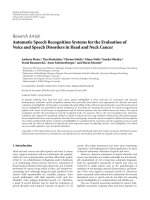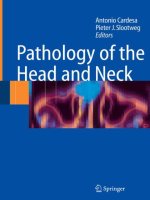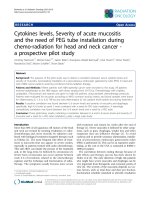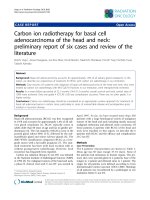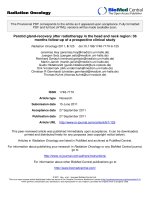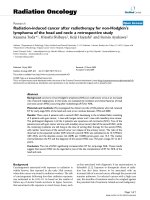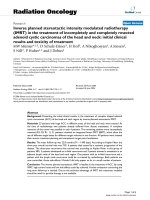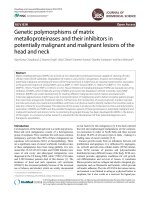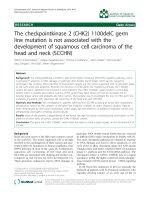Ebook Surgical pathology of the head and neck (Vol 2 - 2/E): Part 1
Bạn đang xem bản rút gọn của tài liệu. Xem và tải ngay bản đầy đủ của tài liệu tại đây (17.84 MB, 274 trang )
Surgical Pathology
of the
Head and Neck
Surgical Pathology
of the
Head and Neck
Second Edition, Revised and Expanded
(in three volumes)
Volume 2
edited by
Leon Barnes
University of Pittsburgh School of Medicine
University of Pittsburgh School of Dental Medicine
Pittsburgh, Pennsylvania
M A R C E L
MARCEL DEKKER, INC.
D E K K E R
NEWYORK BASEL
ISBN: 0-8247-0110-0
This book is printed on acid-free paper.
Headquarters
Marcel Dekker, Inc.
270 Madison Avenue. New York, NY 10016
tel: 2 12-696-9000;fax: 2 12-685-4540
Eastern Hemisphere Distribution
Marcel Dekker AG
Hutgasse 4, Postfach 812, CH-4001 Basel. Switzerland
tel: 4 1-6 1-26 1-8482: fax: 4 1-6 I -26 1-8896
World Wide Web
l
The publisher offers discounts on this book when ordered in bulk quantities. For more information. wrlte to Special Sales/Professional Marketing at the headquarters address above.
Copyright 0 2001 by Marcel Dekker, Inc. All Rights Reserved.
Neither this book nor any part may be reproduced or transmitted In any form or by any means. electronic or mechanical, including
photocopying. microfilming, and rccording, or by any information storage and retrieval system. without permission in writing from
the publisher.
Current printing (last digit):
1 0 0 8 7 6 5 4 3 2 1
PRINTED IN THE UNITED STATES OF AMERICA
This book is dedicated to:
My parents, Mt: r m l Mrs. E l l i s L. Bnrlws, whose sacrifices provided the foundation for achieving many of my
personal goals
The memory of my grandmother, Mrs. Mcrty Barnes, who was a good friend and constant source of inspiration
My wife. C m ) / . who, during the preparation o f this book, gave her unwavering support and tolerated a prolonged
unorthodox schedule
My children, Christy Leigh
writing and editing
trrd
Lori Beth, for providing many pleasant diversions from the seemingly endless tasks of
DL Rohcrt S. Totten, now deceased, and Dt: R o h r t H. Femell,
Jt:.
who taught me the principles of pathology
Preface
Head and neck pathology, defined here as including a l l structures contained in the area from the level of the clavicles to
the sella turcica, has finally come of age and can rightfully take its place among other well-recognized subspecialties,
such as hematopathology, neuropathology. and dermatopathology. Considering allthe tissues contained in this small
area-skin, mucosal surfaces, bone, soft tissue, lymph nodes, salivary glands, odontogenic structures, thyroid, parathyroids,
eyes, and peripheral and central nervous system-onemay
rightfully argue thathead and neck pathology is “nothing
more” than the practice of general pathology above the clavicles. Therein lies the problem. To write a textbook on head
and neck pathology is to write yet another book on general pathology.
The tirst edition of this book was published 15 years ago and took almost S years to produce. Naively, I thought the
second edition would take less time, certainly not the seven years it ultimately did. To this end, I am most appreciative
of a l l the contributors for their time and effort. I am especially indebted to Dr. Charles Waldron, now deceased, who not
only was a contributor but also graciously reviewed numerous manuscripts and made invaluable suggestions; t o my
secretary, Mrs. Donna Bowen, who over the years typedand retyped an endless array ofpapers: and to the staff of
Marcel Dekker, Inc., for patiently guiding me through this venture.
The second edition contains five new chapters on nwlecular biology, fine-needle aspiration, vesiculobullous diseases,
neck dissections, and radiation. The book has also been completely updated and reformated for easier access to specific
information. The index has been expanded and is included in each volume.
As in the first edition, our goal has been to condense into one source the vast literature on head and neck pathology
that is so widely scattered in numerous specialty books and journals. Although we have tried to be thorough, we do not
profess tohavebeen
complete. Only feedback from our readers will determine whether we have comeclose to our
intent.
Leon Barnes
V
Contributors to Volume 2
Billy N. Appel,D.D.S.*
Associate Professor. Department of Oral Medicine and Pathology, University ofPittsburgh
School of Dental Medicine. Pittsburgh, Pennsylvania
LeonBarnes,M.D.
Professor o f Pathology and Otolaryngology, Department ofPathology, University of Pittsburgh
School of Medicine, and Professor and Chairman, Department of Oral Medicine and Pathology, University of Pittsburgh
School of Dental Medicine, Pittsburgh, Pennsylvania
Richard L. Carter,M.D., DSc., F.R.C.P. Department of Histopathology. Royal Marsden Hospital. Sutton, Surrey.
England
Silloo B. Kapadia, M.D. Professor of Pathology and Surgery, Department of Pathology, The Pennsylvania State
University College of Medicine, and Director o f Surgical Pathology, Department of Anatomic Pathology, The Milton S.
Hershey Medical Center. Hershey, Pennsylvania
MarshaC.Kinney,M.D.
Nashville, Tennessee
Mario A. Luna,M.D.
Houston. Texas
Associate Professor. Department of Pathology,Vanderbilt University School of Medicine,
Professor. Department of Pathology, The University ofTexas M. D. Anderson Cancer Center,
Robert L. Peel, M.D.
Associate Professor o f Pathology and Otolaryngology, Department ofPathology, University of
Pittsburgh School of Medicine, and Department of Pathology. Presbyterian-University Hospital, Pittsburgh. Pennsylvania
Steven H. Swerdlow, M.D. Director, Division of Hematopathology and Professor. Department of Pathology. University
of Pittsburgh School of Medicine, Pittsburgh, Pennsylvania
Robert S. Verbin,D.M.D.,Ph.D.*
Professor and Chairman, Department of Oral Medicine and Pathology, University
of Pittsburgh School of Dental Medicine. Pittsburgh, Pennsylvania
*Retired.
vii
Contents of Volume 2
l'
1'11
.r
.rii
IS. Tumors of the Nervous System
787
Silloo B. K q m l i u
lb.
Tumors and Tumor-like Lesions of the Soft Tissues
Leo11 BCrrtws
889
17. Diseases o f the Bones and Joints
Lcou Btrrrles, Rohert S. K>rl>illvRohert L. P d . m d Billy N . Appd
I049
18. Hematopoietic and Lymphoid Disorders
MarsIItr C. Kirlrwy w d Stevm H. Swertllow
I233
19. The Pathology of Neck Dissections
1405
Richtrrd L.
Grrtcr
20. The Occult Primaryand Metastatic Tumors to and from the Head andNeck
Mario A. Lrrrla
l42 I
I- I
ix
Contents of Volume 1
1.
Uses, Abuses, and Pitfalls of Frozen-Section Diagnoses of Diseases of the Head and Neck
1
Mario A . Luncr
2.
Fine-Needle Aspiration of the Head and Neck
15
David Dusenbery
3. Electron Microscopy in Surgical Pathology of the Head and Neck
Jerome B. Rrxy
4. Molecular Pathology of Head and Neck Cancer
87
113
Regina Candour-Edwards rrnd Pcul H. Gumerlock
5. Diseases of the Larynx, Hypopharynx, and Esophagus
127
Leon Barnes
6.
Benign Neoplastic and Nonneoplastic Lesions of the Oral Cavity and Oropharynx
N. Appel
239
Robert S. Verbin, James Guggenheitner, Leon Bames, and Billy
7. Noninfectious Vesiculoerosive and Ulcerative Lesions of the Oral Mucosa
30 I
Susan Muller
8. Premalignant Lesions of the Oral Cavity
Susat1 Muller and Charles A . Waldron
343
9. Cancer of the Oral Cavity and Oropharynx
Leon Barnes, Robert S. Verbitl, and James Cuggenheimer
369
IO.
Diseases of the Nasal Cavity, Paranasal Sinuses, and Nasopharynx
Leotl Barnes, Margaret Brandwein, and Peter M . Son1
439
11.
Diseases of the External Auditory Canal, Middle Ear, and Temporal Bone
557
Leon Barnes crnd Robert L. Peel
12. Diseases of the Trachea
Dennis K. H e m e r
60 I
13. Diseases of the Salivary Glands
633
Robert L. Peel
X
Contents of Volume l
14. Midfacial Destructive Diseases
Leon Barnes
xi
759
I- l
Contents of Volume 3
21. Cysts and Cyst-like Lesions of the Oral Cavity, Jaws, and Neck
Rohert S. Verhin und Leon Burnes
1437
22.
Odontogenic Tumors
Rohert S. Verhin nnci Billy N. A p p d
1s s 7
23.
Developmental Lesions of the Head and Neck
Alfo Ferlito and Alessanclru Rinaldo
I649
24. Pathology of the Thyroid Gland
Virginia A. LiVOlsi
1673
2s.
The Parathyroid Glands
Rol,?:n L. Ape1 unclSylvicr L. Asu
1719
26.
Pathology of Selected Skin Lesions of the Head and Neck
Ste\wl M. Ruhoy, Kevin J. Flynn, Alun R. Silvrrnlan, M u n J ~ a nDd3uzmczn, unrl Michael L. Nielunrl
1793
27. Diseases of the Eye and Ocular Adnexa
Brucr L. Johnson
28.
1877
Infectious Diseases o f the Head and Neck
Mcrrgaret Brc~nclcraitr
2023
29. Radiation Injury
Luis Fdipe Fujurclo
2171
30.
2191
Miscellaneous Disorders of the Head and Neck
Leon Burnes
I- I
xii
Tumors of the Nervous System
I.
11.
111.
IV.
V.
7xx
Organ of Chievitz
Nasal Glioma
Nasal Encephalocele
Traumatic (Amputation) Neuroma
Peripheral Nerve Sheath Tumors
A.
B.
C.
D.
E.
F.
G.
H.
1.
J.
K.
7x8
792
793
Neurilemonla(Benign Schwannoma)
Neurofibroma
Plexiform
Neurofibroma
Diffuse
Neurofibroma
Neurotibromato~is1
Neurofibronlatosix 2 (NF-2; Bilateral AcoustlcNeuroma)
AcousticNeuroma (Unilateral)
Mucosal
Neuroma
Neurothekeoma
Pcrineurioma
Granular Cell Tutnor
Meningioma
VII. Pituitary Adenoma
A. Pituitary Carcinoma
VIII. Craniopharyngioma
IX. Paraganglioma
B.
C.
D.
E.
X.
809
X10
x12
x13
X17
VI.
A.
795
795
79x
800
X03
X03
806
X08
X22
X26
x27
830
X30
x3 I
x3 I
Carotid Body
Jugulotympanic
Vagal
Laryngeal
OtherSites (Orhltal. Thyroid, Nasal)
832
X32
Malignant Peripheral Nerve Sheath Tumor (Malignant Schwannoma, Neurotibrosarcoma)
XI.
XII.
Olfactory Neuroblastoma
Melanotic Neuroectodermal l’umor of Infancy
XIII. Ewing’s Sarcoma and Primitive Neuroectodermal Tumor (Peripheral Neuroepithelioma)
References
787
836
84 1
845
848
852
788
I.ORGAN
Kapadia
OF CHIEVITZ
Introduction. The juxtaoral organ of Chievitz (JOC)
is a normal microscopic anatomical structure that
was first
described in 1885 by the Danish histologist Chievitz (1).
This nonneoplastic epithelial structure has
been the subject
of a detailed monograph (2). The function of the JOC is
as of yet unknown. The suggestion has been made, but
not universally accepted, that it might have neuroreceptor
functions.
Clinical Features. TheJOC is locatedattheangle
of themandible,bilaterally,
near thebuccotemporalis
fascia and is intimately associated with branches of the
buccal nerve (3-10). Lutman found these structures in the
softtissue on theanteriormedialsurfaces
of 9 of 14
hemimandibulectomyspecimens at apointwherethe
ascending ramus joins thebody (4). These structures were
located near the medial surface of the pterygomandibular
ligament deep to the minor salivary glands.
Tschen and
14 of 25 consecutive
Fechner noted theirpresencein
autopsies, in 3 of which they could demonstrate bilaterality (5). Danforth and Baughmanfoundtheseepithelial
nestsassociated with sensorynervefibers
in 11 of 25
autopsy specimens evaluated(3). JOC have been noted in
all age groups, including newborns, stillborns,and adults
(3). There is no gender bias.
Pathology. JOCis not usuallyvisualized on gross
examination, although it may measure up to 0.8 cm in
maximum dimension. Itis important to recognize theJOC
on histological examination because it has a potential for
beingmisdiagnosed as perineuralspread of carcinomas
arising from this area(2-10). Histologically, JOC is characterized by an ovoid zoneof condensed connective tissue
containing clusters of small well-defined nests of squamous epithelial cells exhibiting intercellular bridges and
Figure 1 Juxtaoral organ of Chievitz: A normal anatomical
structure composed of small well-defined clusters of epithelial cells intimately associated with nerves (arrow). It must
not be confused with penneuralinvasion by a carcinoma
(hematoxylin and eosin stain [H&E] X400.)
bordered by cells of the basal type, some with palisading
nuclei, in close proximity to small myelinated nerves (Fig.
1) (3). Thecellnestshave
been observedbetween or
adjacent to axons of small nerves and not actually in the
perineuralspace (4). Thecellshave an eosinophilicor
clearcytoplasm and varying-sizedcytologicallybland
nuclei, with uniform chromatin distributionand inconspicuous nucleoli. Although intercellular bridges are observed
in the cell nests, there is
no evidence of keratin formation
or keratohyalin granules. Occasionally, duct-like lumina
have been described. Mitoses are absent. JOC are mucicarmine-negative, whereas periodicacid-Schiff (PAS) stain
shows a prominent basement membrane around the
cell
nests (3). Dense core granules resembling neurosecretory
granules have been noted on ultrastructural examination.
Differential Diagnosis. Becausethenests of squamous epithelialcells in JOCare in closeproximityto
nerves, they may be confused for perineural invasion in
oral carcinoma (2-4,7-9,ll). Difficulty in diagnosis may
arise on permanent sections or during intraoperative froor
zen-sectiondiagnosis.givingrisetoerroneousstage
unnecessary surgical intervention (4). The differential diagnosis includes perineural spread
of squamous cell carcinoma, adenoid cystic carcinoma, or mucoepidermoid carcinoma. The characteristic anatomical location
and normal
nuclear features lacking cellular atypia distinguish JOC
fromcarcinomas. In addition,thereis no stromaldesmoplasticresponsetotheJOC,whereasinvasivesquamous cell carcinoma is often associated with this feature.
II. NASALGLIOMA
Introduction. Heterotopicmature glial tissuepresenting outside the craniospinal axis most frequently occurs in and around the nose and is referred to as "nasal
Tumors of the Nervous System
glioma” (NG) (1-3). Used in this context, the term nasal
“glioma” is a misnomer as it implies a true neoplasm
capable of autonomous growth. NG is not a true neoplasm.
but instead is a congenital malformation in which there is
anterior displacement of mature cerebral tissue that has
lost its connection with the intracranial contents, perhaps
as a consequence of sequestration of an anterior or nasofrontal encephalocele (3). Although the term “heterotopic
nasal glial tissue” is more appropriate thannasal glioma
for this lesion. the latter is entrenched in the literature and
is familiar t o the headandneck surgeons. Therefore, its
continued usageis probably justified, provided itstrue
nature is explained in the surgical pathology report.
Clinical Features. The clinical findingof a congenital nasofrontal mass presenting in infancy or childhood is
usually duc to either a nasal glioma, nasal encephalocele,
or nasal dermoid (1-10). Although mostNGpresentat
birth, some mayremain asymptomatic and present later
in life (3). There is no sexual prevalence. In the study by
Yeoh et a l . , allbut I of22 lesions were known to be
congenital; 1 child who had nosymptoms atbirthpresented withan intranasal mass present for several years
(3). I n the same study, I 1 of22 cases were operated on
in the first 6 months of life and 20 (90%) by the age of
2 years (3). There is no familial occurrence or associated
congenital abnormality in patients with NG; however,
glial heterotopias arising i n the pharynx may be associated
with cleft palate or choana1 stenosis i n about one-third of
the cases. The heterotopic glial mass is situated externally
on or near the bridgc of the nose i n 60% of cases, within
the nasal cavity i n 30% of cases, and in 1 0 % both
intranasal and extranasal components are present (3-24).
Less frequently, glial heterotopia may present in other
extracranial sites of the head and neck (“facial glioma”),
such as the nasopharynx. palate, tongue. paranasal sinuses,
tonsil, orbit, mandible. or face (25-28). A recentreport
describes the occurrence of glial heterotopia in the midline
occipital or parietal scalp. gluteal region, and even away
from the midline in the temporal region of scalp and chest
wall (29).
Presenting manifestations of NG include a mass causing nasal obstruction or external nasal deformity (Fig.
2A) (3-24). It presents a s a solid. noncompressible, nonpulsatile, gray or purple mass (1-3 cm) filling one side
of the nose and causing airway obstruction. NGs are
usually solitary, but may rarely present as multiple masses
(3). Intranasal lesions are often attached high on the lateral
wall in the region of the middle turbinate. Extranasal
lesions usually present as a smooth noncompressible subcutaneous mass on either side of the dorsum of the nose,
near the inner canthus. or between the frontal, nasal.
ethmoid, and lacrimal bones. The overlying skin may be
789
normal or have a blue or red discoloration. When combined, the intra- and extranasal components communicate
through a defect in the nasal bone. NG lacks a connection
with the cerebrospinal fluid (CSF) pathway and does not
contain a fluid-filled space connected with either the
ventricles or the subarachnoid spaces of the brain. The
Furstenberg test (in which expansion or pulsation of the
mass occurs on application of pressure to the ipsilateral
jugular vein) is, therefore, negative in NG.
Radiography. Radiographs, computed tomographic
(CT) scans,and magnetic resonance imaging (MRI) reveal
the presence of a soft-tissue mass in or around the nose,
with no associated intracranial component or any bony
defect in the floor o f the anterior cranial fossa (8,18). If
such communication is found. then the lesion qualifies as
an encephalocele, rather than a NG.
Pathology. On grossexamination, a NG appears as
a polypoid, smooth,soft, gray tan, nontranslucent mass
with encephaloid features. Histologically, NGs are composed of an unencapsulated disorganized mixture of neuroglial tissue and fibrovascular tissue. The large clumps
or small islands neuroglial tissue display evenly spaced
astrocytes withinan abundant fibrillarmatrix (Fig.2B).
The neuroglial tissue is often traversed by interlacing
bands of vascularized fibroconnective tissue that merge
with the collagen of the mucosal lamina propria or dermis
(1-3. 11-24). The relative amounts of glial and fibrous
tissue vary. Recurrent NG or lesions presenting i n children
older than I8 months of age tend to contain a considerable
amount of fibrosis and may be misdiagnosed as a fibrosed
nasal polyp or fibroma (Fig. 2C) ( 3 ) . Neurons are usually
rare or absent. although in rare instances a prominent
neuronal component has been reported in NG (3,24); Yeoh
et a l . identifiedrare neurons i n 6 of 22 NG studied (3).
The cause for the paucity of neurons in NG, whether
owing to ischemic changesor lack of differentiation of
the isolated primitive neuroectoderm, is unclear. Mitoses
are absent. The astrocyte nucleimay appear enlarged or
multinucleated. These “gemistocytic” astrocytic changes
are reactive. and they should not be confused with malignancy. The presence of choroid plexus, ependyma-lined
clefts, or pigmented retinal epithelium is observed in some
glial heterotopias, especially those found i n the palate
and nasopharynx. However, tissue elements from other
embryonic germ layers are absent.
Phosphotungstic acid-hematoxylin staining may help
identify glial fibers, but when suspected, the presence of
ectopic glial tissue can be easily confirmed by demonstrating positivity for glial fibrillary acidic protein (GFAP),
neuron-specific enolase (NSE), and S-l00 protein (3,3031). These stains do not, however, distinguish between
ectopic glial tissue inNG and herniated brain tissue of
790
Kapadia
Figure 2 (A) Nasal deformity secondary to heterotopic neuroglial tissue (nasal glioma). (B) Heterotopic
neuroglial tissue in the nasopharynx
presentingwithairwayobstruction
in a 14-day-old baby boy. (C) Disorganized neuroglial cells with evenly
spaced
nuclei
are seenwithina
prominent fibrous stroma in this na1 l-year-old boy.
sal glioma from a
H&E, X 115; (A: Courtesy of EN
Myers, Eye and Ear Hospital, Pittsburgh, PA. B: Courtesy of E Yunis
and J Hubard,Children'sHospital,
Pittsburgh, PA.)
an encephalocele.Electronmicroscopicexamination
of
suchasnasalencephalocele
(NE),nasal dermoid,and
heterotopic glial tissue reveals features of astrocytes, such more
remotely, a teratoma (1-3,7). Occasionally, NG may
asthepresence of elongatedinterdigitating cell processesalsobemistaken
for an inflammatorynasalpolyp.Nasal
associated with continuous
a
basement
membrane
encephaloceles
(NE)also
present
at
birth
and may
be
(15,19,29).
NGs.indistinguishable
clinically
from
In contrast to a
Differential Diagnosis. The clinical differential diag- NG,
in which the mass of glial tissue is isolatedfromthe
nosis ofNG includesothernasofrontalcongenitallesions,intracranialcontents,the
NE representsaherniation of
'hmors of the Nervous System
brain tissue through a bony defect
in the skull(1-10). This
communication with the intracranial ventricular systemor
subarachnoid space leads to a positive Furstenberg test in
some, but not all, encephaloceles (see discussion in Sec.
111, Encephalocele). A definitivediagnosis,however,
should await radiographic imaging(8). CT and MW allow
visualization of the soft-tissue mass, with an intracranial
connectionin an encephalocele (8). Histologically, although neurons are generally easily found
in an encephalocele and are sparse or absent in NG, there is an overlap
and the distinction between these lesions is not always
possible (1,3). Furthermore, the ectopic cerebral tissue in
bothlesionsshowsreactivity
for glial fibrillary acidic
protein (GFAP), S-100 protein, and neuron-specific enolase (NSE).
Nasal dermoid cystsor dermal sinuses represent developmental abnormalities that contain only ectodermal elements, without tissue elements from the other embryonal
germ layers (1,4-10). Failure of the fonticulus nasofrontalis or foramen cecum to close allows dermal elements
to invaginate through the frontonasal suture line area
or
betweenthedevelopingnasalbonesandcartilage(2).
Nasal dermoids present on the dorsum of the nose with
an intra- or extranasal cyst that can be clinically mistaken
foreither NG or NE. The association of asinustract
located at any point from the glabella to the base
of the
columellaischaracteristic. In some nasal dermoids an
intracranialconnection may beseen on CT or MRI.
Histologically,nasaldermoids
are easilydistinguished
because they are lined by epidermis replete with dermal
appendages and lack glial tissue (1,2,7).
791
Occasionally,recurrent or long-standingheterotopic
glial tissueismistakenforfibrosedsinonasalpolyp
or
fibroma, when there is increased fibrosis relative to the
glial tissue(3,32).Itshouldberemembered,however,
that sinonasal polyps are highly unlikely occurrences in
the newborn infant or even in childrenyoungerthan 5
years of age. Furthermore, sinonasal polyps are bilateral,
oftenmultiple,
and present asglistening,translucent
masses that fill the nasal cavity or sinuses. Histologically,
sinonasalpolypstypicallydemonstratestromaledema,
thickening of themucosalbasementmembrane,
and a
chronic inflammatory cell infiltrate, including eosinophils.
The history of acongenitalmassshouldsuggestthe
possibility of heterotopic glial tissue, ratherthan a sinonasal polyp, and the diagnosis can be confirmedby demonstrating immunoreactivity for GFAPor S-IO0 protein (1).
Finally,themerepresence
of respiratoryepithelium
(sinonasal) or ependymal-lined clefts in NGs should not
bemistakenforteratoma.Because
of theirmalignant
potential, teratomas containing neuroglial tissue should be
distinguishedfrompureNGsthathave
no malignant
potential. Teratomas are neoplasms that arise from germ
cells and are composed of tissue elements formed from
all
three germ layers (ectoderm, mesoderm, and endoderm);
(1,33-35). Extracranial teratomas are rareand account for
less than 5% of teratomas in childhood. They have been
reported in the neck; nasopharynx, oropharynx, or hypopharynx;face; and orbit (1). Pharyngealteratomasare
often disfiguring, with extreme malformation and associated respiratory distress or cleft lippalate (1). Teratomas
may be solid and/or cystic and are histologically classified
792
as mature or immature, the latter containing tissue of
neuroectodermal origin. Less than S% ofhead and neck
teratomas in children have a malignant component ( I ) .
Treatment and Prognosis. The treatment ofNGis
surgical excision. Withno evidence ofan intracranial
connection, adequate initial excision offers a cure in most
cases (9,10,21). The importance of radiographic imaging
(CT and MRI) performed before surgery in any congenital
nasofrontal mass, toexclude the possibility ofan intracranial connection, cannot be overemphasized. At operation no bony defect is found in NG, but in 10-15% of
cases a fibrous connection may be seen to persist with the
cribriform plate. NGs may recur or persist in 15-30% of
patients, usually following incomplete excision, but there
isno evidence of local aggressive behavior norof any
malignant potential.
111. NASALENCEPHALOCELE
Introduction. Meningoceles and encephaloceles are
herniations of meninges alone or meningeal-lined brain
substance that communicate with the intracranial ventricular system and subarachnoid space through a bony defect
in the skull (1-8).
ClinicalFeatures.
Most encephaloceles present at
birth, although some may be diagnosed later in life. About
80% of all encephaloceles occur in the area of the cranial
vault, 15% in the frontal-ethmoidal (sincipital)region and
less than 5% basally (9-28). Nasal encephaloceles (NE)
may be asymptomatic, or they may present with a nasal
mass or deformity, nasal obstruction, recurrent meningitis,
or cerebrospinal fluid (CSF) leak. About one-third of NEs
are associated with other midline facial anomalies, such
as cleft palate or choana1 stenosis. Patients with encephaloceles usually,butnot invariably, have a positive Furstenberg test, which constitutes pulsation-expansion of the
mass seen on compression of the ipsilateral jugular vein.
To avoid the increased risk of meningitis or life-threatening CSF leak resulting from the spread of infection along
the intracranial communication, a congenital nasofrontal
mass should be considered to be an encephalocele until
proved otherwise by radiographic imaging before surgery.
Although encephaloceles that involve the cranial vault
or the fronto-ethmoidal area generally present as external
masses, basal encephaloceles herniate internally and,
therefore, are clinically difficult to diagnose (9-32). However,CT and MRIscanshave
greatly facilitated the
diagnosis (2 1,23,32-35). Basal encephaloceles are classified based on anatomical location of the skull defect and
pattern of extracranial extension of the encephalocele
cavity, as follows: (a) transethmoid, through the cribriform
plate into the anterior nasal cavity; (h) sphenoethmoid,
Kapadia
through the sphenoethmoid junction into the posterior
nasal cavity; (c) spheno-orbital, through the superior orbital fissure or osseous defect into the orbit; (d) transphenoidal, through the body of the sphenoid into the nasopharynx or sphenoid sinus; and (e) sphenomaxillary
through the junction of the body and wing of the sphenoid
into the pterygopalatine fossa.
Only about SO cases of lateral basal sphenoidal encephaloceles have been reported to date (23-32). Lateral sphenomaxillary basal encephaloceles in which the cystic malformation protrudes into the pterygopalatine fossa with
widening of the superior and inferior orbital fissures are
extremely rare (32). They may present with unilateral
decreased vision or with nonlocalizing symptoms, and on
radiographic imaging, they protrude through defects in
the greater wing ofthe sphenoid and. rarely, into the
infratemporal fossa. A recent report described a sphenomaxillary encephalocele located inthe pterygopalatine
and infratemporal fossae causing widening of the inferior
orbital fissure and communicating with the middle cranial
fossa through an enlarged foramen rotundum (32). Temporal lobe epilepsy may be associated with basal encephaloceles that herniate through the base of the greater sphenoid
wing in theregionofthe
foramen rotundum and the
pterygoid process.
Radiography. A skull defect, seen on radiographic
imaging, including CT and MRI, shows a smoothly marginated lesion which, depending on its content, may have
the same image characteristics as brain or CSF (32-35).
The use of CT and MRI together allows better visualization of the soft-tissue mass in NE with its connection to
the brain through a bony defect in the skull.
Pathology. The excised lesion in a meningocele
shows a cystic mass composed of loose areolar connective
tissue in the dermis, whereas thatofan
encephalocele
shows fully formed cerebral tissue with easily found
neurons or disorganized islands of neuroglial tissue surrounded by collagenous septa (1-2,36). Ependyma and
choroid plexus may be present. The presence of glial tissue
may be confirmed by demonstrating immunoreactivity for
GFAP, S-100 protein, and NSE. NE of long-standing from
children older than 18 months of age mayresult
in
excessive fibrous tissue relative to the amount of glial
cells and may be associated with an absence of neurons
(I-2,36).
Differential Diagnosis. The clinical differential diagnosis includes mainlyNG and nasal dermoid and, less
often, a sinonasal polyp ( 1 , I 1,36). The Furstenberg test is
generally positive in NE because of its connection to the
subarachnoid space.This test is negative in NG, most
nasal dermoid cysts and sinonasal polyps. As mentioned
under the discussion for nasal glioma (seeSec. 11). the
Tumors of the Nervous System
distinction between NE and NG cannot bemadewith
certainly on histological examination, and it is important
to perform radiographic imaging (CT and MRI scans)
to demonstrate the communication with the intracranial
contents through a bony defect in NE. When NE of longstanding results in excessive fibrous tissue relative to the
amount of glial cells and is associated with an absence of
neurons, the histological distinction between NG and NE
may be impossible (l-2,36). Nasal dermoidcysts may
also show an intracranial connection, and are often associatedwith a sinus tract. Histologically the dermoid cyst
lacks glial tissue and is lined by epidermiscontaining
dermal appendages.
Treatment. Following radiographic imaging, excision through a combined intra- and extracranial approach
with closure of the dural defect is safer than the transnasal
approach (15-17,22).
Pathogenesis. Theories of formation of NE include
arrested closure of bone of the frontal floor, and early
outgrowth ofneural tube preventing closure of cranial
coverings (37).The transsphenoidal typemay occur as
part of the median facial cleft syndrome, which includes
median craniofacial dysraphism (38). Patients with orbitotemporal neurofibromatosis often have partial or complete
absence of the greater wing of the sphenoid, resulting in
a defect in the posterolateral wall of the orbit (39).
Although the pathogenesis of sphenoidal encephaloceles is unknown, it is possible that lateral basal encephaloceles may result when ossification centers of the greater
wing of the sphenoid fail to fuse with those of the body
of the sphenoid (32). Occasionally, an acquired mass of
herniated brain tissue may be found in the nose related to
prior trauma (posttraumatic encephalocele) or sinonasal
surgery (40).
IV. TRAUMATIC
(AMPUTATION)
NEUROMA
Introduction. Although discussed with neurogenic
tumors, the traumatic or amputation neuroma is a reactive
nonneoplastic process, rather than a true neoplasm (1-9).
It is a pseudotumor that results when the proximal segment
of a disrupted peripheral nerve undergoes a proliferativereparative response, while the distal segment undergoes
wallerian degeneration (1-4). Etiologic factors include
previous trauma or surgical procedures, including amputations. Failure to recognize neuralinjury after trauma or
inadequate surgical repair with scar formation may be
important factors in the development of traumatic neuroma (2).
ClinicalFeatures. Traumatic neuroma may occur at
any age. In one series, 50% of cases occurred in the third
793
and fourth decades, with two-thirds following trauma and
one-third following amputation (2). The mass may occur
at any site and, depending on the nerve involved, may be
asymptomatic or may manifest withpain or tenderness,
paresthesia, loss of sensation, muscle weakness, or paralysis (1-4). Cieslak and Stout reviewed 63 such neuromas
following trauma (2). The most common symptom in this
series was pain (41 cases), anesthesia (24cases), and
paralysis ( 17 cases), and the duration of symptoms ranged
from 2 months to 20 years (2). On physical examination
the mass varies in size. although most are less than 2.0
cm in diameter.
The principal features of traumatic neuromas in the
head and neck are no different from those at other sites
(3-7). The mental foramen, lower lip, and tongue are
commonoral sites of traumatic neuroma, which may
follow dental extraction, soft-tissue trauma or elective
surgery (3-5). Daneshvar reviewed 14 cases of traumatic
neuroma detected in laryngoscopic biopsy specimens (6).
Hoarseness, dysphagia, choking spells, intermittent aphonia, and cough were themost
frequent symptoms of
lesions of the pharynx. The mean age of the 8 females
and 6 male patients in this series was 59 years (6). The
site was the vallecula (6 cases), aryepiglottic fold (3
cases), pyriform sinus (2 cases), pharyngoepiglottic fold (2
cases), and arytenoid (1 case). At laryngoscopy, traumatic
neuroma appears as a small, solitary submucosal nodule.
Pathology. On gross examination, traumatic neuroma
usually appears as a gray-white.firm,
circumscribed,
bulbous nodule, without a true capsule (Fig. 3A). Normal
healing follows trauma or surgery if the distance between
the severed nerve ends is narrow. However, if the gap is
large or filled with fibrosis, blood clot, or infected tissue,
the proximal and distal segments maynot be ableto
establish contact with each other. The distal end ofthe
proximal nerve segment then proliferates in a bulbous,
tumor-like, haphazard fashion, with regenerated axons and
Schwann cells in interlacing bundles passing through
the scar tissue (Fig.3)(2).This
disorganized bulbous
proliferation of all elements of the nerve fascicles (axons,
Schwann cells, and fibroblasts) supported by scar or granulation tissue is referred to as a “traumatic neuroma” (Fig.
3B) (1-4).
Differential Diagnosis. Traumatic neuromas are
composed of a nonencapsulated haphazard proliferation
ofall elements of the nerve fascicles embedded in scar
tissue. They may be confused histologically with cutaneous leiomyoma, plexiform neurofibroma, or mucosal neuroma, associated with multiple endocrine adenomatosis
type 11 syndrome(MEN 11: see later discussion in this
section).The presence ofmyofibrils on trichrome stain
or, more specifically, immunoreactivity of the spindle
Kapadia
Figure 3 Traumaticneuroma: (A)
Gross specimen shows abulbous
massarisingfromthestump
of a
severed nerve. (B) The residual normal nerve is expanded by a bulbous
tumor-like mass of disorganized
nerve
bundles
and
scar
tissue
(H&E, X 40).
cells for desmin or muscle-specific actin distinguishes a
leiomyoma. Some traumatic neuromas may contain ganglion cells. This finding may suggest the possibility of a
ganglioneuroma, which is a true neoplasm, rather than a
reparative pseudotumor (6). Ganglioneuromas are encapsulated and found most frequently along the sympathetic
ganglion chain. Binucleateor multinucleate ganglion cells
arecommon in ganglioneuroma,butarequiterare
in
nonneoplastic lesions such as traumatic neuroma.
If mucosalneuroma is considered in thedifferentialdiagnosis,
thepossibility of multipleendocrineneoplasia (MEN)
syndromes(type Ilb) can be clinically excluded by obtaining a serum calcium level
and looking for the presence
of hypertension or a palpable thyroid mass, features not
associated with atraumaticneuroma.Furthermore,
patientswithtraumaticneuromashaveahistory
of prior
trauma or surgerytotheinvolvedarea,
and the surrounding tissueis fibrotic, a findingnot present in mucosal
neuroma.
Treatment and Prognosis. When symptomatic, excision of the traumatic neuroma with repair (neurorrhaphy)
and approximation of the distal and proximal segments of
the nerve is the recommended treatment. The lesion may
need to be excised to distinguish it from recurrent malignancy in individualspreviouslyoperated
on forcancer (9). With adequateexcision and repair,there may
berecovery or improvement of sensation and motion.
Traumatic neuromas may recur. Reapposing the cut ends
Tumors of the Nervous System
of nerves after surgery or trauma prevents their development.
V. PERIPHERALNERVESHEATHTUMORS
Introduction. Peripheral nerve sheath tumors may
bebenign or malignant. The benign types include the
closely related tumors neurilemoma (benign schwannoma)
and neurofibroma. Neurofibromas may be of the solitary.
diffuse or plexiform types. Malignant schwannomaor
malignant peripheral nerve sheath tumors (MPNST) may
occur de novo, or arise i n a neurofibroma, or in ;I plexiform neurofibroma (PNF) in patients with von Recklinghausen’s disease (neurofibromatosis I ; NF- I ) . Malignant
transformation is extremely rare i n neurilemoma.
A.
Neurilemoma (Benign Schwannoma)
Introduction. Neurilemoma (benign schwannoma.
neurilemmoma. neurinoma) is a common. histologically
distinctive, benign, usually encapsulated, peripheral nerve
tumor of Schwann cell origin (1-7). I t can arise from any
nerve in the body associated with Schwann cells. including
the cranial nerves (with the exception of the olfactory and
optic nerves), as well as autonomic nerves and peripheral
nerves.
ClinicalFeatures.
Although any agegroup maybe
affected, most patients are between the ages of 20 and S0
years, with an equal sex incidence ( I ) . Most neurilemomas
are solitary and arise in soft tissues. In rare instances,
they may be multiple or associated with NF- 1 ( I , 3 ) . The
head and neck, flexor aspects of the extremities, posterior
mediastinum, and retroperitoneum are common locations,
although any site may be involved (1). About 2 5 4 5 % of
neurilemomas present in thehead and neck, withthe
lateral neck being the most frequent site (8-9). The spinal
roots and the cervical. sympathetic, and vagus nerves are
commonly involved (I).Less frequent sites include the
oral cavity, wherc the tongue is the preferred site, paranasal sinuses (mainly the maxillary antrum and ethmoids),
nasalcavity, nasopharynx, orbit, parapharyngeal space,
larynx, oral cavity. and other unusual sites (9-30). Neurilemomas of the larynx are uncommon and mostoften
present i n the supraglottic region, including the false
cords, aryepiglottic folds and arytenoids. Bilateral acoustic
neuroma (neurilemoma ofthe eighth cranial nerves) is
diagnostic of neurofibromatosis 2 (discussed in Sec. V.F).
Neurilemomas are often asymptomatic and moveable,
typically attached to or arising from the nerve. Depending
on their site in the head and neck, the tumors may interfere
with swallowing, phonation, or cause airway obstruction.
Facial nerve tumors may cause hearing loss, vertigo, otitis
media. postauricular pain, or facial nerve palsy.
795
Radiography. Cohen et al. found areas ofmixed
attenuation onCT,usually
considered an indication of
malignancy, i n histologically proved neurilemomas, correlating with confluent areas of hypocellularity adjacent to
densely cellular or collagenous regions, cystic degeneration. or xanthomatous change (31). Varama et al. found a
target pattern on MRI scans in half of neurofibromas and
neurilemomas, the peripheral hyperintense rim and central
lowintensity, corresponding histologically to peripheral
myxomatous and central fibrocollagenous tissue (32). This
study also found that inhomogeneity on MRI can represent
benign or malignant disease (32).
Pathology. On gross examination, neurilemomas appear as eccentric. discrete, globular, expansile masses.
Most are 1 4 cm in size. although some may belarger.
The nerve of origin can at times be seen stretched over
the surface of the encapsulated neurilemoma and the cross
surface ofthe tumor isgray-tan, myxoid, and solid to
cystic, with recent or old hemorrhage being common (Fig.
4A). The histological appearance is distinctive in that the
tumor isusually encapsulated and displays two classic
growth patterns in highly variable proportions, referred to
as Antoni A andAntoni B types (Fig. 4B) (4,lM). The
Antoni type A patternis
characterized by a compact
arrangement of elongated spindle cells with wavy nuclei
andpoorlydefined borders i n loosely arranged fascicles
having a palisading arrangement of nuclei, theVerocay
body, and stromal hyalinization (Fig. 4C) (7). The Antoni
type B pattern is characterized by a less orderly arrangementof fewer spindled tumor cells i n a loose myxoid
stroma. In the sinonasal tract and nasopharynx the tumors
tend to be unencapsulated and, when combined with
hypercellularity, often raisethe suspicion of malignancy
(13). Unlike neurofibroma, neurilemomas do not contain
axons and are typically separated fromthe nerve fibers
by a capsule. Vessels with thick hyalinized walls and
microcystic changes may be prominent. Mitoses are rare
or absent, but some cells may display enlarged hyperchromatic nuclei, which should not be mistaken for a malignant criterion.
Many histological variants of neurilemoma have been
described, including, degenerated or ancient. cellular (3336), glandular (37-39), epithelioid (40,41), plexiform
(multinodular; 42-50), multiple schwannomas (“schwannomatosis”). and melanotic schwannomas (S 1-6 I ) . These
variants may cause diagnostic difficulty and be mistaken
for sarcoma; however, they have no prognostic significance.
Cellular schwannomas are often located in the paravertebral sites in the pelvis, retroperitoneum, and mediastin u m , and are circumscribed or encapsulated tumors that
are composed predominantly or exclusively of Antoni A
796
Kapadia
Figure 4 (A) Cross section of a
parapharyngeal
neurilemoma
with
attachednerve:
Note thehemorrhagic and cystic degeneration ofthe
mass. (B) Neurilemomadisplaysa
well-developed fibrous capsule and
an AntoniApattern.
(H&E stain,
X40); (C) Higher magnification of
Anton1 Apatternconsistingofa
compactarrangement of elongated
spindle cells in loosely arranged fascicles having a palisading arrangementofnuclei(Verocaybodies).
Antoni B pattern (top left)hasa
lessorderlyarrangementoffewer
spindled tumor cells in a loose myxoid stroma (H&E, X 230).
areas,withoutformed
Verocay bodies (1.33-36). They
displayintersectingfascicles,whorls
of Schwanncells,
and long fascicles of Schwanncellsarranged in aherringbone pattern (1). Mitotic activity may be seen, but is
low (fewer than four per ten high-power fields; HPF) and
foci of necrosis may be present in 10% of cases. These
necroticfociaresurrounded
by differentiatedSchwann
cells (1).
Goldblum et al. further expanded the histological spectrum of neurilemomas by describing three casesof neuroblastoma-like neurilemoma,which on occasion may histo-
logically mimic a neuroblastoma (62).The involved sites
were the superficial soft tissues of the neck, palm, and
flank.Thisvarianthasafibrouscapsulesuggestinga
perineurium, with areas of typical neurilemoma- and neuroblastoma-likezones (62). The latter are composed
of
sheets or groups of small rounded or spindled Schwann
cells with scant cytoplasm and central dark nuclei lacking
significant atypia. The cells often form perivascular
rosettes,pseudorosettes, and rosettes around central cores
of radiating spokes of collagen. Mitoses are rare. Necrosis
and hemorrhage are absent.
-mors of the Nervous System
797
a
5
(discussed later). With the S-l00 proteinimmunostain,
Ultrastructurally, neurilemomas are composed of cells
neurofibromas
show variable staining of tumor cells. In
showing featuresof differentiated Schwann cells (63-65).
contrast with neurilemomas, which areassociated with
Interdigitating slender cytoplasmic processes covered by
NF-l in 18% of cases (3) and rarely undergo malignant
a prominent, often reduplicated, continuous layerof basal
change,neurofibromasareoftenassociated
with N F - 1
lamina constitutethe single most important ultrastructural
andhaveadefiniterisk
of malignanttransformation.
characteristic of thetumorcells.Theyaredevoid
of
Therefore,it is importanttodistinguishbetweenthese
pinocytoticvesicles. The nucleiandcytoplasm of neutwo closely associated tumors.
rilemomasand its variantsarediffusely
and strongly
Cellularneurilemoma, with itsherringbonepattern,
immunopositive for S-100 protein, and a smaller propormay bemistakenformalignantschwannoma,fibrosartion of cells may be epithelial membrane antigen- and
coma, or leiomyosarcoma. However, the increased celluglial fibrillary acidic protein-positive (66-69). Tumor cells
larity in this variant is disproportionately high compared
are negative for synaptophysin, neurofilament, and
PGP
with the level of mitoses and atypia, and features such as
9.5. According to Weiss et al., CD34 is expressed by a
circumscription or encapsulation, perivascular hyalinizadistinctivecellpopulationinperipheralnerve,benign
tion, and strong, diffuse immunoreactivityfor S-l00 pronervesheathtumors,andrelatedlesions,cytologically
and immunophenotypically different from a fibroblast
and
teinshouldsuggestabenigndiagnosis.Differentiated
Schwann cells surround the necrotic foci, rather than the
conventionalSchwanncell(70).Nervegrowthfactor
receptor immunoreactivity has been shown in human behyperchromatic anaplastic cells seen around necrotic foci
nign peripheral nerve sheath tumor (71).
in malignant schwannoma (1). Fewer than 5% of cellular
Differential Diagnosis. Neurilemomas should be disneurilemomasrecurandnoneundergometastasis(1).
tinguishedfromneurofibromas,andotherspindlecell
Cellular schwannomas should be distinguished from matumors, such as leiomyoma, meningioma, fibrous histiocy- lignant peripheral nerve sheath tumorsby the relative lack
toma, and monomorphic synovial sarcoma.The characterof mitoses and necrosis (33-36).
istic features of neurilemoma, including the presence of
The neuroblastoma-like variant of neurilemoma is disencapsulation, the two typesof Antoni areas (i.e., cellular
tinguished from neuroblastoma or primitive neuroepitheAntoni A areas with Verocay bodies, and loose myxoid
lial tumorby the presenceof microscopic areasof convenAntoni B areas), and uniformly intense immunostaining
tional neurilemoma with strong diffuse S-IO0 positivity,
for S-100 protein distinguish neurilemoma from neurofiabsence of immunoreactivity for PGP 9.5, and ultrastrucbroma (1,66). In addition, frequent degenerative changes
tural featuresof Schwann cells (62). Melanotic schwannoand hyaline thickeningof vascular walls are typically seen mas may be difficult to separate from melanoma. Howin neurilemoma and are usually absent in neurofibromas
ever, over half the patients are associated with Carney's
798
syndrome, andthe tumors are usually circumscribed or
encapsulated with psammoma bodies present in most
cases and focal areas reminiscent of neurilemoma ( I ,72).
Similar to melanoma, this variant of neurilemoma is
positive for S-100 protein and HMB45, and shows melanosomes and premelanosomes on electron microscopy.
Except for the presence o f melanosomes, the cells resemble Schwann cells, with cytoplasmic processes that interdigitate ( 1 ).
Neurilemomas are histologically distinguished from
leiomyomas, fibrous histiocytomas, and monomorphic synovial sarcomas by identification ofthe
characteristic
Antoni A and Antoni B patterns of proliferation and diffuse immunoreactivity for S-100 protein, together with absence of reactivity for muscle markers (desmin and actin)
and cytokeratins. Meningiomas typically have a dual immunoreactivity for vimentin and epithelial membrane antigen (EMA). However, in rare instances, it maynotbe
possible to inlt~lunohistochemicallydistinguish between
neurilemomas and meningiomas, because both tumors
maybe positive for vimentin, EMA, and S-100 protein.
In these cases, the ultrastructural demonstration of tumor
cells surrounded by basal lamina may be helpful in confirming Schwann cell features in neurilemoma (63-65).
Treatment and Prognosis. Simple excision with
preservation of the nerve of origin, if possible, is considered adequate therapy. In contrast to neurofibroma in
which the nerve isanintegralpart
of the neoplasm and
must be sacrificed to excise the tumor, neurilemomas are
separated from the nerve fibers by a fibrous capsule,
making it possible i n most instances to excise or enucleate
the tumor without damage to the nerve. Total excision is
usually curative. Neurilemomas are slow-growing tumors,
which maynot cause a problem even when incomplete
excision of the lesion is performed to prevent damage to
the adjacent nerve. Radiation therapy is not effective in
these tumors. Malignant transformation of neurilemoma
is exceedingly rare, andfrom a practical point of view,
this can be discounted (I,73-75).
B. Neurofibroma
Introduction. Neurofibroma is a benign, usually
well-defined, but nonencapsulated, tumor of Schwann cell
origin ( 1 ). “Solitary” neurofibroma is a localized neurofibroma that, by definition. occurs outside the setting of
neurofibromatosis 1 (NF- I o r von Recklinghausen’s disease) ( 1 ). Solitary neurofibroma is far more common than
its inherited counterpart associated with NF- 1. However,
the diagnosis ofsolitary neurofibroma is alwaysconditional, especially in young individuals, because the presence of one may herald the onset of others ( I ) .
Kapadia
Clinical
Features.
Patients with solitary neurofibroma are generally young. between the ages of 20 and
30 years ( I ) . There isnosex
predisposition. Solitary
neurofibromas are slow-growing, painless, superficialtumors of the dermis or subcutaneous tissue, evenly distributed over the body ( l ) . When associated with NF-I,
neurofibromas are multiple or segmental in distribution,
superficially o r deeply located. and more likely to undergo
malignant transformation ( 1 ).
The head and neckregionis
a common location for
neurofibromas, which often present in the skin and subcutaneous tissue as small, soft, sessile or pedunculated tumors (2-5). However, other sites, such a s those involved
by neurilemoma, may less frequently be involved, including the nasal cavity (6,7). paranasal sinuses (6,8,9), nasopharynx ( 6 ) , orbit (10-14), conjunctiva (IS), parapharyngeal space (16), larynx (l7-33), maxilla (34-36), oral
cavity (37-39), and mandible (40). Neurofibromas of the
larynx are rare and maybe solitary or an uncommon
component ofNF-I (17-33). They should be included
in the differential diagnosis of a submucosal smooth
supraglottic mass, although the tumor may also arise from
thevocal cord or subglottis (17-33). Hoarseness and a
sensation of a lump in the throat on swallowing may be
the initial manifestation. Most orbital nerve sheath tumors
affect the first division of the trigeminal nerve and present
withanorbital
mass, withpain or sensory loss being
unusual ( 1 2). In one study, 25% of patients with orbital,
isolated neurofibromas, but none with neurilemomas, had
associated NF- 1 (12).
Radiography. In a study of CT scans in parapharyngeal neurofibromas (16), the tumors appeared a s wellcircumscribed, moderately enhancing masses in 10 of the
IS patients. In a review of 32 extracranial nerve sheath
tumors (23 benign and 9 malignant), Varmaet al. found
a target pattern on MRI scans in 5/10 neurofibromas and
7/13 neurilemomas, the peripheral hyperintense rim and
central low-intensity corresponding histologically to peripheral myxomatous and central fibrocollagenous tissue
(41). Moreover, they found that MRI cannot distinguish
between neurofibromas and neurilemomas, and that benign nerve sheath tumors may mimic their malignant
counterparts when necrosis and cystic or hemorrhagic
degeneration is present (41).
Pathology. Ongrossexamination, neurofibromas are
white-gray and lack degenerative changes. Most often.
these tumors arise from small nerves and extend into soft
tissue, resulting in a well-circumscribed, but nonencapsulated mass ( l ) . However. less frequently, the tumor may
arise in and expand a large nerve to form a fusiform mass,
when, if confined by the epineurium. a true capsule may
be present ( l ) . With the exception of “plexiform” neurofi-
Tumors of the Nervous System
799
Figure 5 Neurofibroma of floor of
mouth: (A) In contrast to neurilemomas
(see Figure 4B), neurofibromas are not
encapsulated. (H&E, X50); (B)microscoplcally, they are composed of undulating Schwann cells and axons (H&E,
X 140).
broma (to be discussed later), solitary neurofibromas have
thesamehistologicalfeaturesasthoseneurofibromas
associated with NF- 1.
Histologically, in contrast with neurilemomas, which
are
encapsulated
and
contain
more
a homogeneous
population of cells,neurofibromasare not encapsulated
and arecomposed of amixture of varyingproportions
of Schwann
cells,
fibroblasts,
axonal
processes
of
neurons, and perineurialcells(Fig.5Aand
B). Widely
separatedirregularspindled or stellatecells with long,
thin cytoplasmic processesand wavy dark-staining nuclei
are loosely arranged in a fibrous or myxoid matrix rich
in mucopolysaccharide (1,43). The amount of cells and
fibromyxoidstromavaries.
The stromacontains mast
cells, lymphocytes and, rarely, xanthoma cells (1,42,43).
Less frequently, neurofibromas may be cellular and composed of fascicles of Schwann cells in a uniform collagen
matrixdevoid of myxoidsubstance (1). Focalatypia
or raremitosesare
not uncommon in neurofibroma
or theplexiformvariant.However,
when seentoa
marked degree, malignant transformation should be considered.
The nerve sheath origin of neurofibromas can be confirmed immunohistochemicallyor ultrastructurally. Neurofibromasdemonstrate S-100 proteinpositivity,butthe
positivity is variable in a given lesion and not as striking
in intensity or uniformity as in neurilemoma (1,s). Ultrastructurally, spindle-shaped cells, with long and thin bipolar cytoplasmic processes, bearing discontinuous external
laminas and numerouspinocytoticvesicles,areseen
widely scattered in a stroma of fibrillogranular material
and bundles of collagen fibrils (1,8,43,44). The predomi-
nant cellshaveultrastructuralfeaturesmoreconsistent
with perineurial cells than Schwann cells (43).
Differential Diagnosis. In contrast with neurilemomas, which arepredominantlycomposed
of Schwann
cells,neurofibromascontainavariety
of cellsthatare
associated with peripheralnerves:
namely, perineurial
cells,fibroblasts,entrapped
axons, and Schwanncells
(1,4344). Furthermore, they lack a capsule,Verocay bodies, hyaline thickeningof vascular walls, Antoni A and B
growth patterns, and degenerative change
(1). At times,
however, itmay be difficult to distinguish between cellular
neurofibroma and neurilemoma because of the presence
of common features of benign nerve sheath tumors.
In
such cases, histochemical stains to determine the presence
of acid mucopolysaccharide-rich myxoid matrix in neurofibromas, which is absentinneurilemoma,
may be of
diagnostichelp (1). The nervesheathorigin
of these
tumors is confirmedby the demonstrationof immunopositivity for S 1 0 0 protein, which is less striking in neurofibroma than in neurilemoma (1). If special stains are not
useful, then the noncommittal term “benign nerve sheath
tumor” is appropriate.
Treatmentand Prognosis. Whenever possible, simple excisionis the treatment of choice (1,3,18). Aggressive
debilitating surgery should be avoided.
In the study by
Rose and Wright of 54 orbitalperipheralnervesheath
tumors, despite incomplete resectionof some tumors, with
follow-up up to23 years, no recurrences requiring further
surgery were found (12). Although solitary neurofibromas
do not have the same incidence of malignant transformation as neurofibromas associatedwith NF-l, the exact risk
is unknown, but is probably quite small (1).

